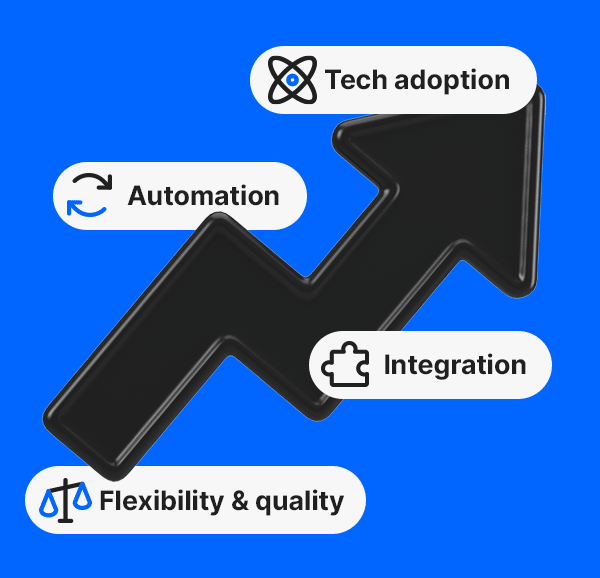Operating internationally means navigating vastly different regulatory landscapes. Each country presents unique payroll challenges, from compliance deadlines to complex tax structures and local regulations. Managing global payroll across jurisdictions requires precision to avoid costly missteps and compliance risks.
The surprising reality is that rather than converging toward global standards, payroll performance gaps between regions are actually widening. Our 2025 Global Payroll Efficiency Index (PEI) report, analyzing data from the 2024 calendar year, reveals that regional differences in payroll efficiency are becoming more pronounced, not less.
Dramatic shifts in regional performance are reshaping the global payroll landscape, with the Americas, EMEA, and Asia-Pacific each developing distinct efficiency patterns driven by regulatory complexity, local practices, and varying rates of technology adoption among providers and payroll services.
How is global payroll complexity evolving?
Some of the findings that we’ve uncovered from this year’s PEI report, and our own associated research, indicate the scale of just how different payroll processes can be. And this is down to:
- Regulatory variations: some countries can complete payroll cycles quicker than others, due to varying payroll regulations and tax laws. For example, while calendar length in the United States is just 3.59 days, it’s over two weeks in Estonia.
- Gaps in technology maturity: automated payroll systems are spreading globally, but unevenly. Organizations with automation can identify and resolve issues far more efficiently than those using manual processes. Regional variations in adoption have been found in our adjusted measurements for data input issues and issues per 1000 payslips.
- Talent accessibility challenges: 78% of payroll, HR and finance leaders say that payroll professionals significantly impact compliance adherence. This reflects growing challenges in maintaining specialized expertise across multiple jurisdictions — whether due to skills gaps, staffing shortages, or the increasing complexity of country-specific regulatory requirements.
- Data unification demands: 94% of payroll, HR and finance leaders say disconnected systems and solutions are a challenge, with integration making a real difference to payroll data efficiency.
- Payment integration requirements: payment timeliness has dropped from 99.28% to 99.12% this year, emphasizing the need to adopt unified platforms that can address the root causes of payment delays.
- Economic and geopolitical developments: regional turbulence creates direct payroll challenges. Economic instability forces frequent adjustments and corrections, as evidenced by extremely high supplementary impact rates of 139.89% in Brazil and 76% in Argentina.
What are the key regional payroll trends in 2025?
Once again, the PEI report has explored six key metrics in CloudPay customers in over 100 countries worldwide. Analyzing the results at a regional level has uncovered these trends:
AMER
The Americas is no longer the regional leader in FTA: a drop of 3.09% to 78.97% has seen it fall behind Asia-Pacific. But at the same time, calendar length has reduced from 5.80 days to 5.40 (bucking the global trend) and it’s now the regional leader on the new DII measurement at 0.34 issues per payslip.
Much of this may be down to greater adoption of monthly payroll driving efficiency gains, and more countries favoring flexibility over rigid approval processes. Stand-out results at national level include Uruguay’s FTA of 91.42%, and very low DII rates in Bolivia (0.09) and Paraguay (0.10).
EMEA
EMEA remains the most stable of the three regions, and this continues in 2025 — most metrics have only risen or fallen by small amounts. FTA, for example, is down 1.05 to 66.86%, and calendar length has reduced from 8.20 days to 7.10.
This stability stems from EMEA countries balancing rigor with efficiency, with greater automation adoption helping navigate a complex regulatory environment across the region’s different countries. As in previous years, the United Kingdom demonstrates this approach with the lowest FTA rate globally (43.49%), while Croatia has recorded exceptional results of zero supplementary impact and a DII rate of just 0.03.
APAC
The APAC region has previously suffered with some under-performance due to payroll speed being prioritized over quality. However, this year’s results suggest a deliberate change in approach, largely supported by the increase in technology adoption.
APAC now has the highest regional FTA rate at 79.86%, with China posting the highest national figure globally at 96.54%. Meanwhile, its calendar length has jumped up by over 50% in just one year (from 4.10 days to 6.20). Considered alongside a very high DII rate of 1.40 issues per payslip, and a supplementary impact rate that is low and stable, this suggests a much more diligent and careful approach to getting payroll operations right.





